Home / Compare Pet Insurance / Cat breeds and pet insur…

Key takeaways
- Some breeds may be genetically predisposed to certain illnesses and health conditions, so research which type of feline friend would suit your household.
- Any health conditions your cat had before you took out cover for them can affect the price you pay for pet insurance.
- Illness and injury can happen to any cat at any time, so getting pet insurance earlier in your cat’s life is important.
Most popular cat breeds in Australia
When choosing the right cat to bring into your home, considering characteristics such as fur, size, temperament and general health can be wise before you make a final decision.
We’ve compiled the top cat breeds quoted through our pet insurance comparison service1 and their common personality traits and types of health problems that could impact your pet insurance.
1. Domestic shorthair
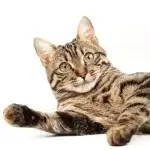 Domestic shorthairs are the most common pet cat quoted for through Compare the Market’s pet insurance service.1 They don’t belong to any particular recognised cat breed (being a mix of breeds) and are simply characterised by their short fur.2 These domestic cats are typically playful, docile and quiet, and can make great companions for children and adults alike.
Domestic shorthairs are the most common pet cat quoted for through Compare the Market’s pet insurance service.1 They don’t belong to any particular recognised cat breed (being a mix of breeds) and are simply characterised by their short fur.2 These domestic cats are typically playful, docile and quiet, and can make great companions for children and adults alike.
Due to their mixed parentage, domestic shorthairs don’t have any known hereditary conditions. However, common house cats can be prone to obesity and should have a balanced diet.
2. Domestic Medium Hair
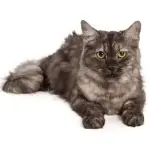 As the second most popular cat breed entered in Compare the Market’s pet insurance service,1 the Domestic Medium Hair – like its counterpart the Shorthair above – is a mix of various other cat breeds and is distinguished only by its medium-length coat.3 In general, these cats are playful and loving companions and can thrive in any household that gives them care and attention.
As the second most popular cat breed entered in Compare the Market’s pet insurance service,1 the Domestic Medium Hair – like its counterpart the Shorthair above – is a mix of various other cat breeds and is distinguished only by its medium-length coat.3 In general, these cats are playful and loving companions and can thrive in any household that gives them care and attention.
Domestic Medium Hairs aren’t prone to any breed-specific diseases and conditions, but they can still experience some general health issues, like kidney disease, diabetes and obesity.4
3. Ragdoll
 The Ragdoll is a long-haired cat breed that is easy to recognise as these cats have distinctive, luxuriant fur and blue eyes.5 These lovable felines are very gentle and playful, and they love being petted and held, so some people call them lap cats.
The Ragdoll is a long-haired cat breed that is easy to recognise as these cats have distinctive, luxuriant fur and blue eyes.5 These lovable felines are very gentle and playful, and they love being petted and held, so some people call them lap cats.
Ragdolls have long fur but not an undercoat, so while they shed a fair amount, matting shouldn’t be an issue. However, they’re prone to certain conditions like hypertrophic cardiomyopathy and bladder stones.
4. Tabby
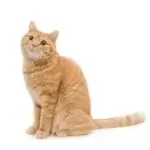 The tabby is not a specific cat breed but rather a coat pattern many domesticated cats and genetic lines have.6 Tabbies tend to have distinctive stripes or whorl patterns on their fur, and often have a marking in the shape of an ‘M’ on their forehead. Common groups of tabby cats include the mackerel (striped), classic, ticker (agouti), patched and spotted tabby.
The tabby is not a specific cat breed but rather a coat pattern many domesticated cats and genetic lines have.6 Tabbies tend to have distinctive stripes or whorl patterns on their fur, and often have a marking in the shape of an ‘M’ on their forehead. Common groups of tabby cats include the mackerel (striped), classic, ticker (agouti), patched and spotted tabby.
Tabbies are mixed breeds and not typically prone to health issues, but you should ensure that your tabby has a healthy diet and proper exercise.
Despite the mix of breeds (and therefore personality traits), tabbies are generally very outgoing, playful and curious, making great pets for all kinds of people and households.
5. Domestic Longhair
 The Domestic Longhair cat is another breed-that-isn’t-a-breed; rather, its ancestry is a mix of various other cat breeds with the only defining trait being their long fur.7 With an affectionate and playful nature, they make for adoring companions, but each may have their own unique personality. They’re also renowned for their natural mousing ability.
The Domestic Longhair cat is another breed-that-isn’t-a-breed; rather, its ancestry is a mix of various other cat breeds with the only defining trait being their long fur.7 With an affectionate and playful nature, they make for adoring companions, but each may have their own unique personality. They’re also renowned for their natural mousing ability.
Like other mixed-breed cat categories, Domestic Longhairs don’t come with predispositions for specific health conditions. However, you should still be aware of general cat health concerns such as worms and fleas, cancer, diabetes and FIV.
6. British Shorthair
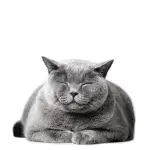 The British Shorthair is a stocky cat with dense fur and a round face.8 They’re known to be gentle and easy-going, making them good house pets. They’re also quite happy on their own and can entertain themselves.
The British Shorthair is a stocky cat with dense fur and a round face.8 They’re known to be gentle and easy-going, making them good house pets. They’re also quite happy on their own and can entertain themselves.
While they’re considered a generally healthy breed, British Shorthairs may experience hypertrophic cardiomyopathy (a form of heart disease), gingivitis and haemophilia B. They also love to eat and relax, so can be prone to obesity.
7. Maine Coon
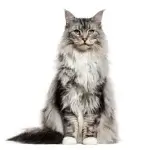 Maine Coons are known for being big in both size and personality.9 They’re gentle giants who love attention, and make for playful and loving companions.
Maine Coons are known for being big in both size and personality.9 They’re gentle giants who love attention, and make for playful and loving companions.
The breed is generally hardy due to their origins in the winters of New England. However, Maine Coons can be prone to hereditary conditions, mainly hypertrophic cardiomyopathy, hip dysplasia and spinal muscular atrophy.
8. Burmese
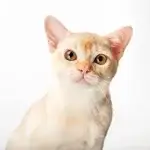 The Burmese cat has a distinctive, glossy coat that comes in a range of colours, including rich brown, silvery blue, chocolate and red.10 In terms of personality, this breed is extremely affectionate, playful and intelligent; they can even be trained to perform tricks! Burmese cats also love attention from both their human owners and fellow cats.
The Burmese cat has a distinctive, glossy coat that comes in a range of colours, including rich brown, silvery blue, chocolate and red.10 In terms of personality, this breed is extremely affectionate, playful and intelligent; they can even be trained to perform tricks! Burmese cats also love attention from both their human owners and fellow cats.
Burmese cats are a rather sturdy breed and aren’t known to experience any breed-specific conditions, so pet owners need only look out for general cat health issues such as worms, fleas, ticks and cat flu.
More information about cat breeds
Which cat breeds are hypoallergenic?
It’s thought that people who have an allergy to cats may be allergic to cat hair itself, household dust that’s carried within their fur or to proteins found in the saliva of cats which ends up on their coat when they groom.11 So while there isn’t a fully allergy-free cat breed, that are some breeds that may be better for those with allergies, including:
- Cornish Rex
- Bengal
- Sphynx
- Russian Blue
- Siberian
- Devon Rex.
What’s the friendliest breed of cat?
Like humans, cats can come with a variety of unique personalities and traits that aren’t always designated by their breed. However, some breeds that have a reputation for being friendly include:12
- Scottish Fold
- Ragdoll
- Persian
- Abyssinian
- Burmese
- Siamese
- Exotic Shorthair
- Maine Coon
- Chartreux
- Sphynx.
What are the healthiest cat breeds?
While any cat can experience illness and disease, there are some breeds that are less prone to hereditary conditions and genetic illnesses. These can include:13
- American Shorthair
- Ragamuffin
- Balinese
- Savannah Cat
- Russian Blue
- Egyptian Mau
- Maine Coon.
When choosing a type of cat to add to your family, be sure to do your research on breeds and only go through reputable breeders. Aside from breed alone, you can also do your part as an owner to take care of your cat; things like regular vet checkups and a balanced diet can help to keep them healthy.
Does cat breed affect pet insurance?
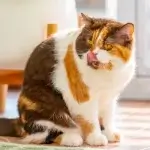 If your cat has a pre-existing condition or history of poor health, potentially because of their breeding, it may be treated as an insurance exclusion or can increase the cost of your pet insurance premiums when taking out a pet insurance policy. Read your Product Disclosure Statement (PDS) for policy terms and common exclusions, as well as the Target Market Determination (TMD) to check the policy is appropriate for you.
If your cat has a pre-existing condition or history of poor health, potentially because of their breeding, it may be treated as an insurance exclusion or can increase the cost of your pet insurance premiums when taking out a pet insurance policy. Read your Product Disclosure Statement (PDS) for policy terms and common exclusions, as well as the Target Market Determination (TMD) to check the policy is appropriate for you.
Can my cat be insured if they have a pre-existing condition?
Some pet insurers don’t provide any coverage for pre-existing conditions, while others will provide some coverage for pre-existing conditions that have been cured or treated (e.g. conjunctivitis, stomach ulcer), although typically at an additional cost. However, this doesn’t mean you can’t insure your cat at all; your pet insurance policy can still cover costs or treatments for any new conditions, illnesses or injuries they may experience later on, just not any related to their pre-existing condition.
Are predispositions the same as pre-existing illnesses?
A predisposition refers to an increased chance of a cat contracting a disease or developing an illness, while a pre-existing condition refers to any illness your pet already has before you take out pet cover. While some breeds are known to have certain health issues, they may not necessarily be born with these conditions, but could develop them later in life or may not have any health issues at all.
Should I insure my cat?
Pet insurance is a smart idea, even if your cat’s breed isn’t prone to health issues. It can provide financial protection if they get sick or injured and for routine care with additional cover. Having the right pet insurance plan can help you claim back some of those costs and provide peace of mind when caring for your feline. It’s best to insure your furry friend (both cats and dogs) early in their life before they show symptoms of any health issues relating to their breed or age.
Meet our pet insurance expert, Adrian Taylor
As a General Insurance expert with over 13 years’ experience in financial services, Adrian Taylor knows that dogs and cats get themselves into all sorts of mischief. One part of Adrian’s work is to help empower consumers to understand how pet insurance can help save them from exorbitant vet bills when their pet gets injured or falls ill.
Want to know more about pet insurance?
1 The breeds listed above are based on data collected from Compare the Market’s pet insurance comparison tool between 1 July 2023 and 31 December 2023 (inclusive) and may vary from other sources.
2 Hill’s Pet Nutrition – Domestic Shorthair Cat Breed — Facts and Personality Traits. Accessed July 2024.
3 PetGuide.com – ‘Domestic Medium Hair’. Written by Lisa Selvaggio, July 2023. Accessed July 2024.
4 Catster – ‘Domestic Medium Hair Cat: Info, Pictures, Facts & Traits’. Written by Kit Copson, updated June 2024. Accessed July 2024.
5 Purina Australia – Ragdoll. Accessed July 2024.
6 The Spruce Pet – ‘Tabby Cat: Breed Profile, Characteristics & Care’. Written by Franny Syufy, updated October 2023. Accessed July 2024.
7 Catster – ‘Domestic Longhair Cat Breed Info: Pictures, Temperament & Traits’. Written by Christian Adams, updated June 2024. Accessed July 2024.
8 Purina Australia – British Shorthair. Accessed July 2024.
9 Purina Australia – Maine Coon. Accessed July 2024.
10 Purina Australia – Burmese. Accessed July 2024.
11 Purina New Zealand – Top 5 Hypoallergenic Cat Breeds. Accessed July 2024.
12 Purina UK – The Most Affectionate and Friendliest Cat Breeds. Accessed July 2024.
13 PangoVet – ‘Top 26 Healthiest Cat Breeds: An Overview’. Written by Nicole Cosgrove, March 2024. Accessed July 2024.



